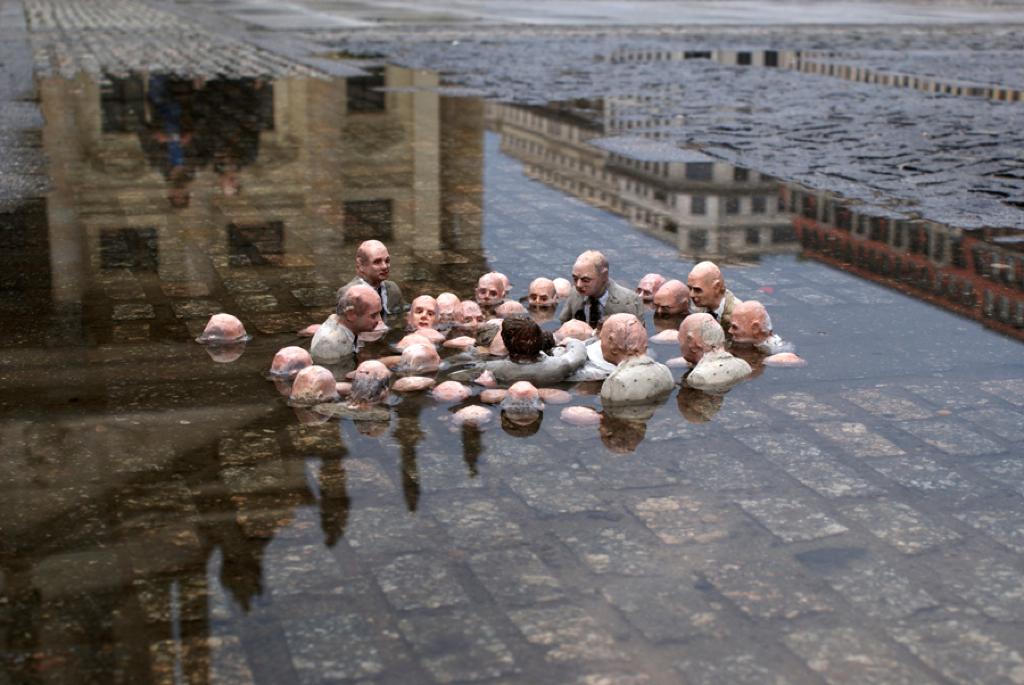This is what politicians debating global warming will look like soon
“Follow the leaders,” Berlin, Germany, April 2011.
“Politicians discussing global warming” — that’s what social media users have dubbed this tiny puddle sculpture by Spanish street artist Isaac Cordal.
The image has gone viral in the past few days and it’s obvious why. With sea levels projected to rise up to three feet by the end of the century, it's a stark reminder of our collective failure to act on climate change.
Or maybe not.
More from GlobalPost: Calamity Calling: A year-long investigation into how climate change is already changing our world
As it turns out, Cordal's sculpture is actually called “electoral campaign” and it's part of a larger street art installation called “Follow the leaders.” The tiny cement figures, arranged in bleak scenes of urban disintegration, represent the faceless businessmen who run our capitalist global order.
“These pieces reflect our own decline,” says Cordal. “We live immersed in the collapse of a system that needs change.”
![]()
Isaac Cordal's "Follow the leaders," Nantes, France, July 2013. (pinokda/Facebook)
Cordal installs the 15 to 25 cm tall sculptures in streets and public spaces across Europe, then photographs them to document their presence. The ongoing work — called “Cement Eclipses” — is meant as social critique, he explains to Phaidon:
“It refers to this collective inertia that leads us to think that our small actions cannot change anything. But I believe that every small act can contribute to a big change. Many small changes can bring back social attitudes that manipulate the global inertia and turn it into something more positive.”
While “Politicians discussing global warming” turns out to be a misnomer, it’s surprisingly attuned to Cordal's vision. As design professor Stuart Candy comments on his blog:
“Intriguing how one audience member recontextualising the artist's work with an alternative title (whether accidentally or deliberately doesn't really matter) gives that work startling potency and a new lease of life.”
Cordal has even addressed climate change in some of his past work. A 2012 installation — “Waiting for climate change” — depicts tiny figures along the Belgian coastline confronting global warming with varying degrees of concern.
![]()
Isaac Cordal's "Waiting for climate change," Beaufort04, De Panne, Belgium, March 2012 (ArTIVISM/Facebook)
A 2013 installation of the same name depicts life-sized figures in business suits floating in the Château des Ducs de Bretagne moat, in France. “Impassive and blasé, they absently watch the water level rise,” notes the artist’s website.
![]()
Isaac Cordal's "Waiting for climate change." Nantes, France, November 2013. (Isaac Cordal/Vimeo)
The theme of global inertia could not be more timely. This week the UN's Intergovernmental Panel on Climate Change meets in Yokohama, Japan to discuss “the impact that rising temperatures will have on humans, animals and ecosystems over the next century,” reports the BBC.
The Yokohama meeting will produce the second of three reports updating the world on the state of the climate — a process last undertaken in 2007. The first report, issued September 2013, highlighted the physical science evidence for human-induced climate change.
![]()
Isaac Cordal. Site-specific installations along the Pontevedra estuary, Galician coast, Spain. (Arrested Motion/Facebook)
Our coverage reaches millions each week, but only a small fraction of listeners contribute to sustain our program. We still need 224 more people to donate $100 or $10/monthly to unlock our $67,000 match. Will you help us get there today?
